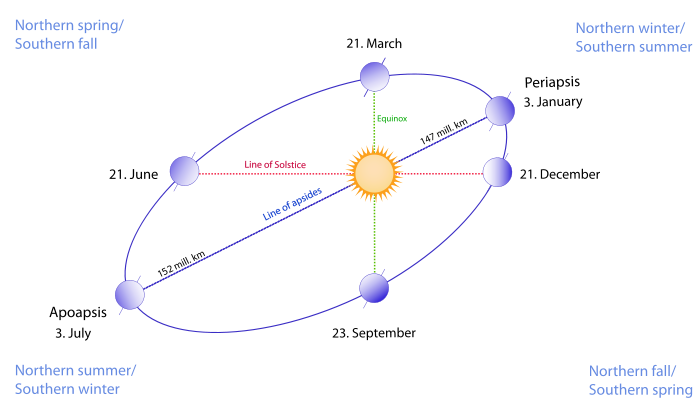Astronomical
The precise timing of the seasons[9] as viewed by astronomers is determined by the exact times of transit of the sun over the tropics of Cancer and Capricorn for the solstices and the times of the sun's transit over the equator for the equinoxes. [10]For 2011 these times are:
Equinoxes Solstices Mar 20 @2321 UTC June 21 @1716 UTC Sept 23 @0905 UTC Dec 22 @0530 UTC
The following diagram shows the relation between the line of solstice and the line of apsides of Earth's elliptical orbit. The orbital ellipse (with eccentricity exaggerated for effect) goes through each of the six Earth images, which are sequentially the perihelion (periapsis—nearest point to the sun) on anywhere from 2 January to 5 January, the point of March equinox on 20 or 21 March, the point of June solstice on 20 or 21 June, the aphelion (apoapsis—farthest point from the sun) on anywhere from 4 July to 7 July, the September equinox on 22 or 23 September, and the December solstice on 21 or 22 December.
In astronomical reckoning, the solstices and equinoxes ought to be the middle of the respective seasons, but, because of thermal lag, regions with a continental climate often consider these four dates to be the start of the seasons as in the diagram, with the cross-quarter days considered seasonal midpoints. The length of these seasons is not uniform because of the elliptical orbit of the earth and its different speeds along that orbit.[11]
From the March equinox it takes 92.75 days until the June solstice, then 93.65 days until the September equinox, 89.85 days until the December solstice and finally 88.99 days until the March equinox. In Canada and the United States, the mass media consider the astronomical seasons "official" over all other reckonings, but no legal basis exists for this designation.
Because of the differences in the Northern and Southern Hemispheres, it is no longer considered appropriate to use the northern-seasonal designations for the astronomical quarter days. The modern convention for them is: March Equinox, June Solstice, September Equinox and December Solstice. The oceanic climate of the Southern Hemisphere produces a shorter temperature lag, so the start of each season is usually considered to be several weeks before the respective solstice or equinox in this hemisphere, in other countries with oceanic climates, and in cultures with Celtic roots.

No comments:
Post a Comment